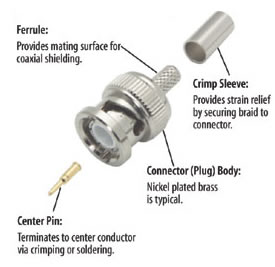What kind of coax cable do antennas need?
(blogger@L-com.com)
As a major US Antenna manufacturer, L-com gets this question quite often. After all, if you are searching for an antenna, you may not think about the cabling requirements up front. But every antenna needs to be connected to a radio, and often the radio and antenna are not placed close together, so a coaxial cable is necessary.
So what kind of cable do you need? There are a couple of factors you should ask yourself:
- How far apart is the radio from the antenna?
- How much signal loss can your application tolerate before the signal doesn't link?
- Will the cable be run between walls, rooms, or floors of a building, like in a Plenum air space?
- Will the cable need to bend and flex for your application or can it lay still?
In most cases, you will need a "low-loss" cable for your antenna, like L-com's CA- series. The higher the number, the thicker the cable and the better the signal loss rating.
CA-400 series bulk cable and cable assemblies
The CA-400 series cable is usually the best choice as it combines excellent signal loss characteristics with a reasonably lightweight, small diameter cable. Because of its popularity, bulk cable and cable assembly options are frequently available off-the-shelf. For applications where fire codes require a special jacket, you can get Plenum rated bulk cable; for high-flex applications, you can get an ultra-flex version.

Connector types
The other thing you have to consider is what type of connector you need. Usually, this will be dictated by the antenna and the radio, because you need a cable that can mate to those two units. But sometimes coaxial connectors can be confusing, especially when you consider reverse-polarity connectors. Browsing an online coaxial connector chart with high-res images can help a lot. There are also handy radio connector type cross reference guides.
Once you identify what you need, you should check the availability of a factory-manufactured finished coaxial cable at the proper length and with the connectors already attached. If you can't find what you need, you may be able to go the custom cable route, though be prepared for minimum order requirements. Another option is to buy bulk coaxial cable and connectors and make the cable yourself.
Making a coaxial cable assembly
There are instructions online to help with this process, but in brief you will need bulk coaxial cable, the connector(s), and proper stripping and crimping tools. Make sure the connector you get is sized to fit on the coaxial cable diameter you are using (if you don't, it's awfully difficult to shoehorn it on there…) You may also want to get tape or shrink tubing to cover the crimped section of the cable to protect it.

No comments:
Post a Comment